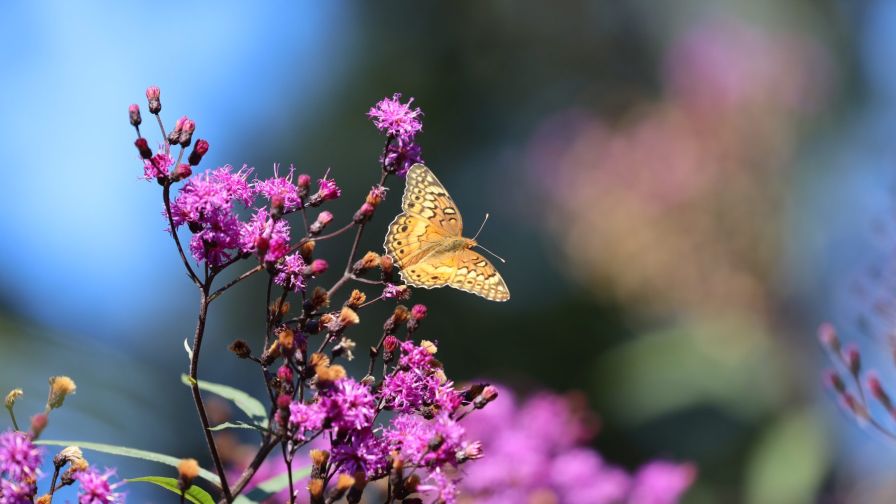
Fritillary on Vernonia | Mt. Cuba Center
According to a four-year trial conducted by Mt. Cuba Center, Vernonia, commonly known as ironweeds, are adaptable native plants that provide beauty and ecological value to almost any garden.
Mt. Cuba Center’s trial evaluated 45 types of Vernonia, including species and cultivars native to the eastern U.S. Results are available now in the new report, Vernonia for the Mid-Atlantic Region. Native ironweed species produce purple flowers in summer and fall and can be found growing in a diversity of habitats in nature, from moist meadows to dry sandhills. The trial highlights the beauty and wildlife value of the ironweed species and cultivars that thrive in average garden conditions in the mid-Atlantic. According to Sam Hoadley, Mt. Cuba’s Manager of Horticultural Research, “While plants like New York ironweed are familiar sights in natural areas of the mid-Atlantic region, people may be surprised to learn just how much value the genus Vernonia can bring to both gardens and wildlife.”
Hoadley and his team ranked the ironweed species and cultivars growing in full sun based on plant vigor, foliage, form, habit, floral display, and disease resistance to determine top performers. The cultivar, Vernonia angustifolia ‘Plum Peachy’, received top marks and showed a floral display that attracted many pollinators. “The Vernonia trial shines a well-deserved spotlight on an incredible yet underutilized genus of native plants that have so much to offer the world of ecological horticulture”, says Hoadley.
In addition to examining Vernonia’s ornamental accolades and horticultural merits, Mt. Cuba’s trial also took an in-depth look at pollinator activity. Volunteers from the Pollinator Watch Team tallied the pollinators they observed visiting each plant and also monitored a Vernonia specialist bee, Melissodes denticulatus, commonly known as the denticulate longhorn bee. Observing these specialist bees gave valuable insight about how to support this insect both in cultivation and in the wild.
The health of plants in the trial appeared to be directly correlated to the number of insect pollinators the various ironweeds tested could support. Simply put, healthy plants attract more insects. The trial also showed that some plants, like the locally native New York ironweed, had more specific cultural needs than a typical garden setting provides, and fell short of the top performer list. However, if this species is sited carefully in areas with moist to wet soils, New York ironweed can be elevated to a functional component of the broader landscape.
Key Takeaways:
- There is a wide diversity of native Vernonia species and cultivars, and many are surprisingly adaptable in cultivation and can serve as both beautiful and ecologically valuable additions to just about any garden.
- Some species of ironweed have specific cultural needs to thrive in cultivation. With careful consideration and proper siting, even plants that performed poorly in the average soil conditions of the trial garden can make great garden plants.
- Some species of ironweed, like Vernonia gigantea, can achieve titanic proportions by late summer, but there are many ironweeds that have shorter habits and may be better candidates for gardens with limited space.
- In addition to generalist pollinators, ironweeds support charismatic specialist insects, such as the denticulate longhorn bee, and serve as a host plant for several species of moths and beetles.
This research report details the top 13 Vernonia in Mt. Cuba’s trial. Descriptions and photos of all 45 plants included in the trial are available at mtcubacenter.org/trials/vernonia.
Mt. Cuba’s Top-Performing Vernonia:
- Vernonia angustifolia ‘Plum Peachy’ (Plum Peachy tall ironweed)
- Vernonia gigantea Alabama ecotypes A & B (giant ironweed)
- Vernonia ‘Summer’s Swan Song’ (Summer’s Swan Song hybrid ironweed)
- Vernonia missurica Arkansas ecotype (Missouri ironweed)
- Vernonia ‘Summer’s Surrender’ (Summer’s Surrender hybrid ironweed)
- Vernonia acaulis North Carolina ecotype (stemless ironweed)
- Vernonia lettermannii ‘Iron Butterfly’ (Iron Butterfly narrowleaf ironweed)
- Vernonia lettermannii Arkansas ecotype (narrowleaf ironweed)
- Vernonia gigantea ‘Jonesboro Giant’ (Jonesboro Giant giant ironweed)
- Vernonia ‘Summer’s End’ (Summer’s End hybrid ironweed)
- Vernonia baldwinii Arkansas ecotype (western ironweed)
- Vernonia noveboracensis South Carolina ecotype (New York ironweed)

